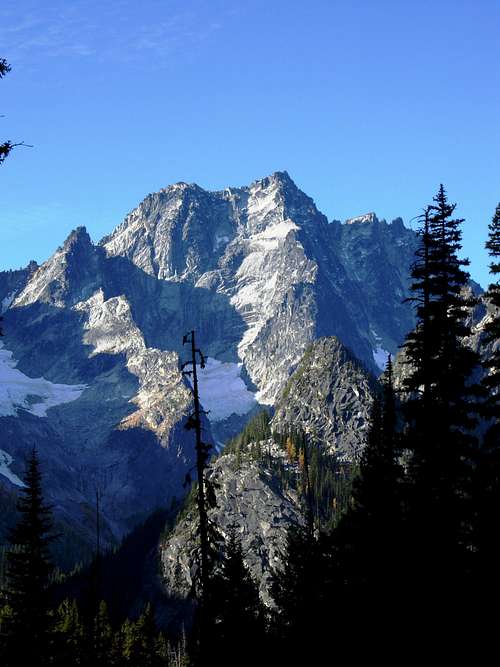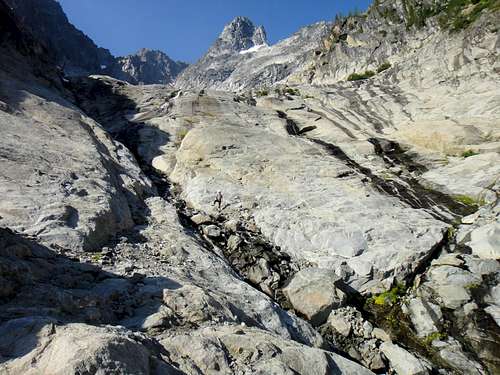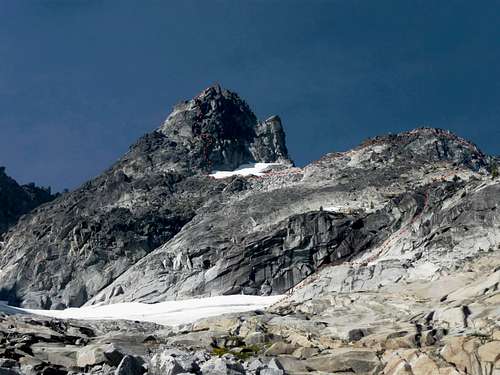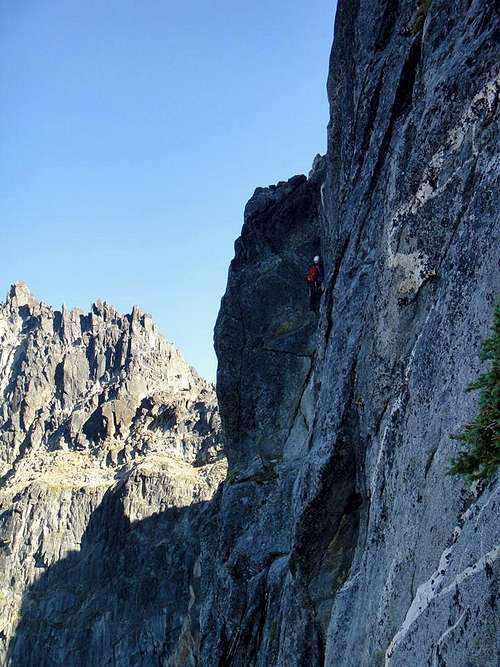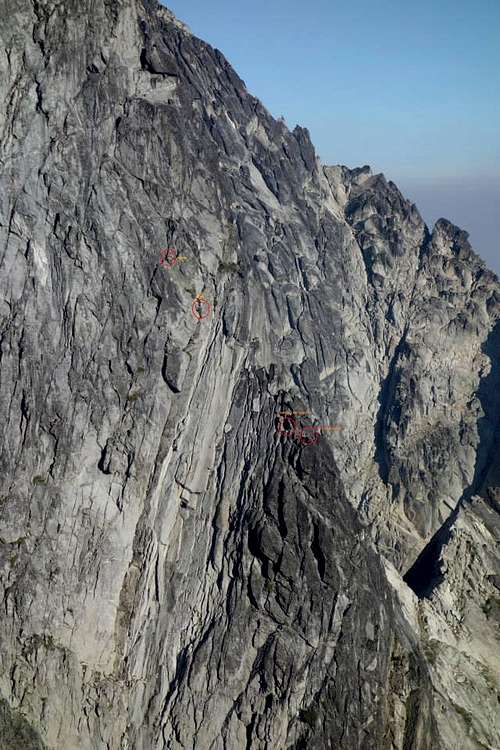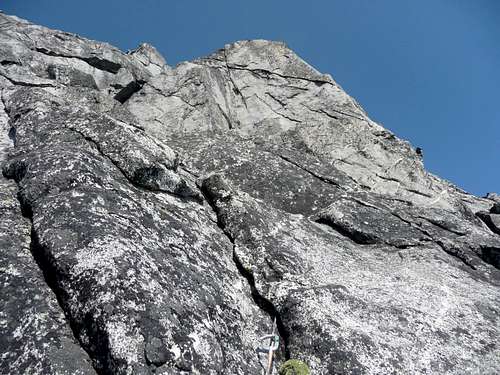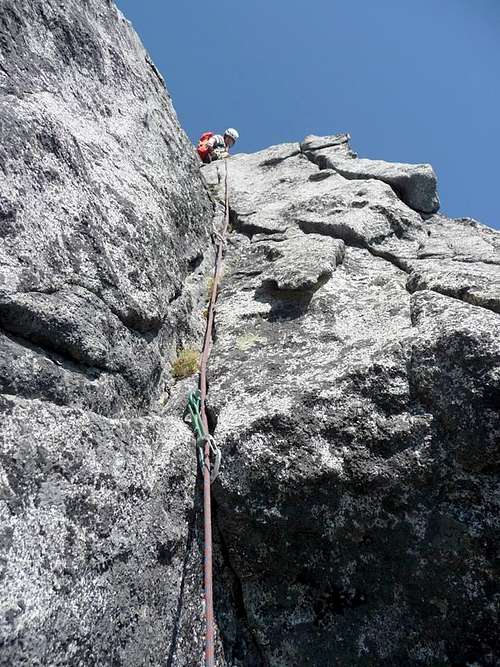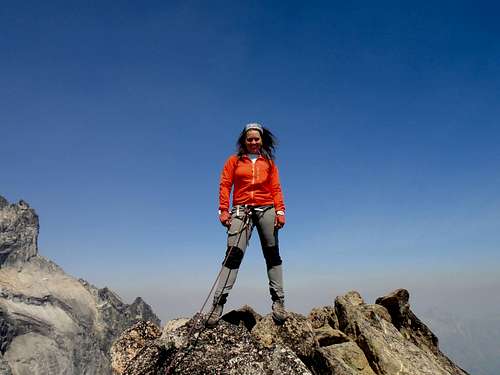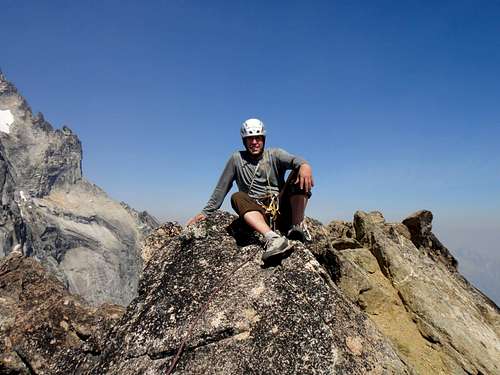-
 5180 Hits
5180 Hits
-
 81.84% Score
81.84% Score
-
 14 Votes
14 Votes
|
|
Route |
|---|---|
|
|
19.67439°N / 139.90797°W |
|
|
Trad Climbing |
|
|
Summer, Fall |
|
|
One to two days |
|
|
5.8 (YDS) |
|
|
20 |
|
|
IV |
|
|
Overview
Mount Stuart's Ice Cliff Arete is the obvious, striking ridge separating the Ice Cliff Glacier from the Sherpa Glacier. Offering 20+ well protected, high quality pitches on beautiful Enchantments white grandiorite, this route compares favorably with many of its more famous neighbors, and surpasses in quality many others. My partner felt the Ice Cliff Arete was more sustained and committing than the full North Ridge of Mt. Stuart. The route finding certainly made it feel more like an adventure climb than the more traveled routes in the range. Unless otherwise noted, all photos are by Anastasia Blagoveshchenskaya.
Getting There
Approach and descend as for the North Ridge of Mt. Stuart.
Season
This is a typical Enchantments range summer alpine rock route, which I find are best climbed late season - August through September. The weather is typically warm and stable and the rock snow free. Additionally, one can eschew ice axe and crampons and wear tennis shoes on the approach. The route has been climbed in early June, however, parties reported wet, snowy rock climbing. The advantage of an early season ascent is one may make an easy descent down the Sherpa Glacier, which is not a safe option later in the season.
Route Description
There has been at least two independent routes established on the Ice Cliff Arete. I will describe the route I climbed, which seems to be slightly more popular and the easier of the two. The consensus seems to be the route is Grade IV with technical difficulties reported from 5.8 - 5.9. I felt the line we climbed was 5.8, but there is considerable route latitude and one could certainly climb much harder variations. I suspect we found the path of least resistance, so future parties should be prepared for sustained climbing to at least 5.8.
- From the basin below the Sherpa Glacier, hike up talus and scree and find beautiful water smoothed slabs. Early season this will be snow. We followed an obvious water course on the right side of the moraine, which steepened to low 5th class, eventually climbing past fixed nuts and pitons. We belayed one pitch.
- Look for an unmistakable, right trending rose quartz dike. In August we had to kick steps up a bit of snow to gain this feature. Climb the dike for thee pitches to the ridge crest, 5.7.
- Traverse along the east side of the ridge, staying on or near the crest to the base of the prominent Black Tower. This is mostly third and fourth class climbing, with occasional steps of exposed, but moderate fifth class. We elected to remain roped up which slowed us down considerably. If I were to repeat this route, I would either un-rope for this section or simul-climb on a shortened rope.
- From the base of the Black Tower (snow patch here, last possible water source) the climbing becomes more sustained and the route finding a bit trickier. Follow fourth class ramps and ledges working your way left, aiming for the unobvious but crucial black dihedral. Climb the dihedral to its top in one long pitch, 5.7.
- Exit the dihedral through a few steep moves, then follow ramps and weaknesses for 6 - 7 pitches first trending right then back left, eventually gaining the left side of the Black Tower which forms a sharp ridge, impressively hanging over the Sherpa Glacier. 5.7 (small bivy site here).
- Climb along the sharp crest crossing the top of a striking, water smoothed gulley through a small roof to the base of the steep headwall, 5.8.
- The route wanders up the headwall for 7- 8 pitches, following cracks, dihedrals, and flake systems to the top of the Ice Cliff Arete, 5.8.
- The top of the arête forms a satisfying and logical conclusion to this route. Since my partner and I had both previously summited Mt. Stuart, we elected to descend from here. One may choose to climb to the summit of Mt Stuart via the third class East Ridge.
- From the end of the climb, descend as per the North Ridge of Mt. Stuart. Alternately, one could enchain the West Ridge of Sherpa Peak and descend via its East Ridge.
Essential Gear
1) Standard rack for a granite alpine rock route. A large size range of pieces is more useful than doubles:
- Full set of nuts
- Cams from 0.3- 2.0 (Camalot sizes). Doubles of small cams (0.3, 0.4. 0.5 Camalot/ green, yellow, red Alien) would be useful, but certainly not necessary.
- Lots of slings to extend placements.
2) Rope. We used a 60 meter cord which seemed about perfect.
3) Plenty of water, the route is dry starting at the Black Tower. There should be snowmelt runoff from the Sherpa Glacier below the route and we found a good trickle from a snow patch at the base of the Black Tower in August.
4) Bivy gear. While very fast climbers (e.g. the late Chad Kellogg) have day tripped this route, we were surprised by how long it is. We had planned on bivying on the descent but got caught by night high on the route even with a 3AM start from the trailhead.
5) Ice axe and crampons in early season for the Sherpa Glacier.
6) Helmet.
External Links
Brief trip report by Craig Gyselinck on CascadeClimbers.com
Trip report by Dan Aylward on CascadeClimbers.com


